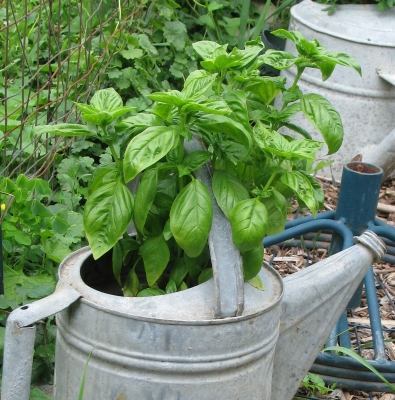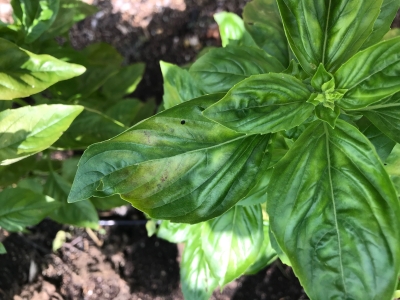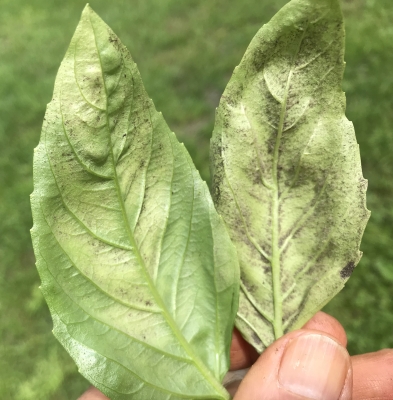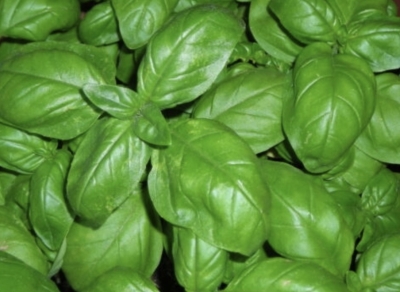RAISING BASIL(S)
Continuing Education
“No occupation is so delightful to me as the culture of the earth, & no culture comparable to that of the garden. Such a variety of subjects, some one always coming to perfection, the failure of one thing repaired by the success of another, & instead of one harvest a continued one thro’ the year. Under a total want of demand except for our family table I am still devoted to the garden. But tho’ an old man, I am but a young gardener.”
That’s what Thomas Jefferson wrote to Charles Willson Peal on August 20, 1811. Mr. Jefferson had it right. One thing, among many other, that makes gardening so rewarding for me is that there’s always something new to learn about plants and their cultivation. 
Take basil, for instance, which I, like many of you, have grown for many years. I’ve always been satisfied with a good harvest, enough for adding pizazz to summer salads and for preserving — dried, or frozen as pesto — for winter. But basil growing became more involved some years ago after a seed company sent me sample packets of a few varieties of basil, and then I spoke with some commercial herb growers.
The Lineup
In spring, I planted short rows of all the varieties I had, with a plastic tag at the head of each row. The tags were unnecessary, for no two varieties looked alike and I could have deduced the variety names by the catalogue descriptions. 
Flavor has always been my reason for growing basil, and I wondered just how different each variety would taste from its neighbor one row over. So I picked leaves of each variety and nibbled them. I rubbed their leaves between my palms, then inhaled deeply their aromas. I invited visitors to sample each variety, and as they sampled I badgered them with questions and jotted down notes. A pasta dinner was needed so we could evaluate each type of basil made into a pesto sauce. What torture!
There actually were differences in taste between the basils. The variety called Sweet lived up to its name with a mild flavor. The similarly mild flavor of Napolitano had the slightest hint of licorice; that of Spicy Globe, the slightest suggestion of mint. Progressively stronger in flavor were Lettuce Leaf, then Fino Verde. The taste of Genova was strong, bordering on acrid. Syracusa was one of the best — strongly aromatic, yet smooth to the palate.
I also grew some of the newer varieties resistant to downy mildew disease. Basil downy mildew is a relatively newcomer here, making itself seen by causing a slight yellowing of the leaves, with purple fungal spores on leaf undersides.

Basil downy mildew, top of leaf

Basil downy mildew, leaf underside
I’ve got little more to say about those varieties because none of their flavors were notably better or as good as the non-resistant varieties, because the disease rarely shows up here, and because it can be controlled with abundant sunlight and good air circulation, and by avoiding infected plants, leaves, or seeds. What’s more, disease resistance is a matter of degree, and various degrees might also exist among the varieties not bred as such.
So, Which to Grow
Honestly, though, the differences in flavor among the tasty varieties were not dramatic; rather, they were subtle nuances of the familiar basil flavor. And tasting a few varieties does put objectivity on shaky ground. Maybe even the order of tasting is important.
So which is the best variety of basil? This brings us back to the striking difference in appearance between the varieties. Since the differences in taste were not that great, I usually choose a basil variety on the basis of plant size, and the size, color, shape, and texture of its leaves. If I want a basil with a very large leaf — perhaps large enough to wrap around a piece of fish to bake — I’ll grow Mammoth.
For drying or pesto, I like a variety with a lot of leaf and a minimum of stem. (The dried stems are useless; they’re basil-flavored twigs.) So any variety except small-leaved Fino Verde or Spicy Globe would be suitable for pesto.
For eating fresh in salads, even the small-leaved varieties are okay, since the fresh, young stems are tender. One of the purple-leaved varieties could be used fresh to add a splash of color in salads.
I might grow some basils just for decoration, even if they had no culinary use. Spicy Globe basil, planted close together, makes soft, green mounds resembling a miniature boxwood hedge — a nice border for a terrace or a flower garden. The deep purple color of Dark Opal would contrast nicely with bright yellow and orange zinnias in a sunny flower border. Purple Ruffles could be used for a more frilly effect. The large-leaved, green basils make an island of lime-green if massed together, with a texture dictated by the leaves of the variety chosen: smooth and shiny, wrinkled, or ruffled.
And who knows, maybe I’ll grow certain basil varieties just for the musical sounds of their names. When someone innocently asks, “What kind of basil is that?” I might gesticulate and sing, “Genova Profumatissima,” “Syracusa,” or “Fino Verde Compatto.”


Well played sir, well played.
I really love ‘African Blue’ basil. It has a sharper tang but I easily substitute it for sweet basil in salads. It is very disease resistant for me in VA where downy mildew has decimated my non-resistant basils. It has beautiful pink blooms well into fall and doesn’t get bitter when it blooms. Bees love it. And, if all that isn’t enough, it survives lower temperatures than regular basil.
Nice, thanks for basil.
try MRIHANI basil from Zanzibar: beautiful and unique flavor
I am growing that this year. I smells wonderful! Can’t wait to make tea from it!!
Different flavour varieties seeds are sold here. I have tried the Thai Siam basil and found it’s flavour very liquorice and very enjoyable – my favourite basil now. Also grew others with very strong flavours; lemon (like detergent), lime (detergent again), chocolate (not really chocolatey)
I found the Genovese basil to be the best basil for cooking. I think soil makes a big difference in how basil tastes. Mine is not acrid at all. Lemon and lime basil make wonderful ice tea!!
Have you tried Rathbone?
No, but I might checkk it out.